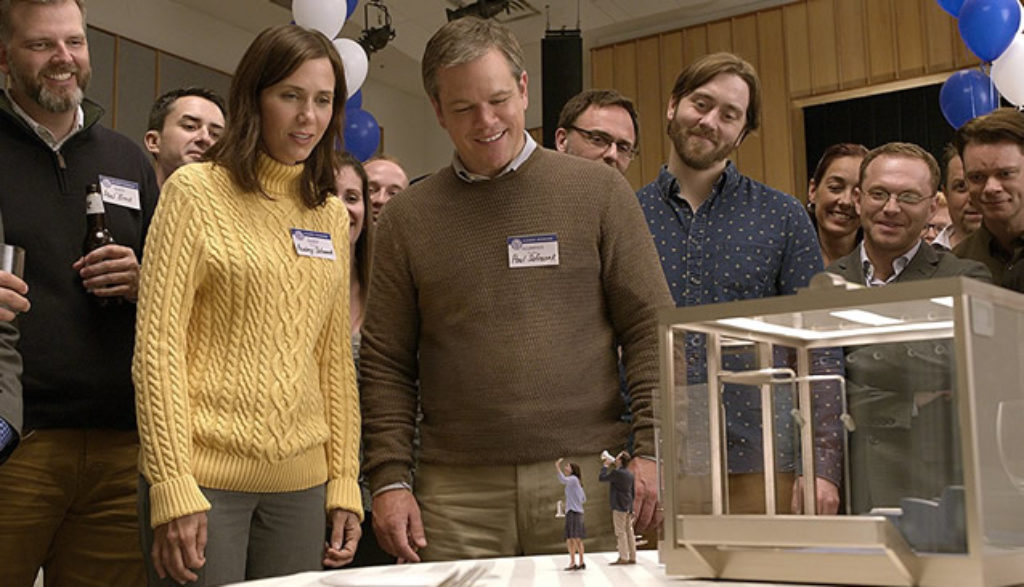
To live large, you gotta live little.
So say the Lilliputian pitch people from Leisure Land. For anyone who wants to live like a millionaire on a thousandaire’s budget, downsizing is the way to go.
Downsizing—the process of shrinking people to the size of Coke cans—wasn’t initially designed to turn beleaguered blue-collars into cup-sized aristocrats. The Norwegian scientists who perfected the process figured it was a tool to save the world. After all, five-inch-tall humans don’t use nearly the natural resources that us big ‘uns might. You don’t need to worry so much about your carbon footprint if it’s the size of a paper clip. Why, one cow could keep the corner McDonald’s supplied with beef for years.
Not that the movement’s altruists would care much for miniature Big Macs (Mini Macs?). But for the rest of us? That stuff’s important. Hey, it’s nice to help out and all, but any economic engine is powered by one question: What’s in it for me?
Soon, communities like Leisure Land begin popping up across the globe—tiny towns where you can live large. When you’re five inches tall, dollhouses feel like mansions. Miniscule plots of grass feel like parks.
Paul and Audrey Safranek listen to the pitch with increasing interest. The Omaha couple still lives in the modest house Paul grew up in, scraping up just enough to get by. Now, thanks to a miracle of science, a life of luxury is within reach.
Sure, the move into minutia has its drawbacks: The process is irreversible, so if you ever change your mind and want to be big again, tough luck. And while downsized folks can visit their still-large friends and family anytime they want, relationships with behemoth brethren won’t ever be quite the same.
But, man, the house! The luxury doodads! The lifestyle! Paul and Audrey decide that the five-inch life is just the right size for them: They sign up to downsize and fly to Leisure Land’s own prep center, ready to undergo the five-hour shrinking procedure.
But when Paul wakes up from the procedure—eyebrows shaved, jaw aching from his replacement fillings—Audrey’s not there. She chickened out—big time, you might say. She’s still on the other side, still tall. And as much as she loves Paul, she won’t shrink for him.
There’s no going back for Paul, of course. He’s stuck. Shrunk. And in a funk. His life just got smaller in more ways than one.
“I should’ve been thinking more about myself!” Audrey tells Paul when she reveals she’s still big. It’s the coda for many a person in Downsizing, both big and small. But in truth, that selfish attitude is rarely part of Paul’s DNA.
Paul’s gig as a big was that of an occupational therapist, helping people deal with workplace pain. He carried his pain-relieving ethos outside the workplace, too. For years, he cared dutifully for his terminally ill mother—sacrificing a potential career as a surgeon to do so. When he comes home from work to find Audrey on the couch complaining of a headache, he comes up behind her and starts rubbing her neck. “Just relax, honey,” he says. “Let me take all the weight.”
Paul’s personality comes in handy after downsizing, when he runs into Ngoc Lan Tran, a Vietnamese refugee who was downsized against her will and who lost a leg somewhere along the way. Ngoc is cleaning little houses now, and Paul immediately sees that her artificial leg is out of whack—causing long-term damage. He offers to help, and she accepts.
Soon, Paul realizes that Ngoc is more concerned with others in her orbit—friends and neighbors and casual associates who are sick, hungry or even dying. She ropes Paul into her goodwill efforts, accepting old food from wealthy homeowners and restaurant managers and doling it out to folks in her tiny tenement. She asks Paul to play a real doctor for a terminally ill woman, hoping to make the lady feel better. She’s wired to help. Even breaking her artificial leg doesn’t stop her: She merely hitches a ride on Paul’s back, spurring him into the fray.
Where does all this altruism come from? Could it be from …
… Jesus? Why yes indeed it could. Ngoc is a fervent Christian, and once she and Paul finish their charitable rounds, she tells him in her broken English, “Now we go church pray Jesus.” Once there, she sways silently to praise music, eyes closed, while others around her dance and wave their hands. Paul looks on, mystified.
Ngoc often talks about how Jesus has given her “special gifts,” about how He “smile for me.” When an opportunity comes up for her and Paul to go to Norway to see the original downsizing community, she tearfully accepts the trip as a blessing from God. And when it looks as though she and Paul will have to part company, Ngoc gives him her most precious possession: her Bible. (When Paul reminds her that it’s written in Vietnamese, she says, “Words not matter. Remember me.”)
The movie treats Ngoc’s faith a bit like a quirky oddity. The church service is played for laughs, and I think we’re meant to smile a little at Ngoc’s innocent naivety when she talks about how Jesus looks out for her. But there’s nothing funny when she tears up in gratitude for her God-given blessings. She’s arguably the most admirable character in Downsizing, and for the movie to play up her faith is, I think, significant.
Paul doesn’t necessarily share Ngoc’s faith. But he does believe that something set him on his path for a purpose. He sees a divine hand at work in his life: Each major step, even each major misstep, led to a specific moment of discovery in his life. And he is, in that moment, grateful for the journey.
A handful of people dress in garb associated with various faiths, from Hindus to Sikhs to Hassidic Jews. There’s a reference to Noah’s Ark. Someone’s compared to a saint. A scientist declares mankind is “too beautiful, too improbable” to simply vanish from the face of the earth. We also hear that mankind has been around for 200,000 years.
In Norway, Ngoc and Paul sleep together. We don’t see anything more than a preliminary tender kiss, but a subsequent (and extremely crass) conversation later leaves no doubt about what happened.
Downsizing also features an extraordinary amount of male nudity in non-sexual situations. Men pose in homage to Leonardo da Vinci’s Vitruvian Man sketch, their genitals quite visible. (Da Vinci’s drawing itself is prominently featured during the closing credits.) Men undergoing the downsizing procedure are stripped naked and lie unconscious on gurneys. We see all of their anatomy from the front and the side.
Two scenes reveal a bit of Paul’s bare backside. Surgical assistants shave his legs up nearly to his pelvic region. After downsizing, Paul reaches toward his groin to make sure everything is proportional.
We see a brief glimpse of a topless woman. As part of a sales pitch, a woman shows off her jewelry while lounging in a tub. (We see her from the shoulders up.) Paul’s neighbor, Dusan, throws a party attended by alluringly dressed women. Also in attendance: “Little Ronni,” the first baby born in a downsized community, all grown up now and a Justin Bieber-like celebrity. Dusan says that Ronni sleeps around a lot: “Women, men, hermaphrodites, goats …” he quips. He also adds that Ronni will likely be the first downsized person to “die of syphilis.” (Later, Ronni sports a sore on his lip indicative of herpes.)
We see people kiss and caress. Someone tells Paul that he should date single mothers and be open to purely physical encounters. Paul and Audrey get divorced.
Paul gets scalded by water. An official at a downsizing facility informs Paul and Audrey that the procedure involves, a 1-in-225,000 chance of injury or death. Potential perils of being downsized include threats from insects and birds. We see a dead bird on protective netting above a downsized community. Dental work has to be removed from folks being shrunk, and we see people in the midst of the procedure (with blood-stained bibs covering their chests).
[Spoiler Warning] The scientists behind downsizing believed that their work might save the world. Now, those scientists and others believe the effort was too little, too late. Dr. Jorgen Asbjørnsen, the first downsized scientist, says the planet is on the cusp of a major extinction event, in which mankind will unquestionably be one of the casualties.
About 25 f-words, most of which pepper the audience in one scene. We hear about five s-words and uses of “a–,” “b–ch” and “crap.” God’s name is misused four times, once with “d–n,” and Jesus’ name is abused thrice—though when it is abused, Ngoc gets really angry.
Paul attends a party where he’s offered a mysterious pill (perched on the tongue of a female reveler). He at first refuses because of “allergies,” but then accepts: He sways on the floor, clearly under the influence, hallucinations mixing with the lights and faces at the party. The next morning, he wakes up on Dusan’s living room floor.
Ngoc grabs prescription meds (Vicodin, Percocet and others) from Dusan’s bathroom—drugs that Ngoc tells Paul she has permission to take. Paul discovers that she wants to ease the suffering of a woman stricken with cancer: Ngoc asks Paul which would help her the most, and Paul says Percocet. He advises giving the sick woman two pills. Ngoc points to the woman’s obvious discomfort and gives her four. Later, Paul returns to Ngoc’s house and finds the woman gone. She died, Ngoc says—admitting that maybe she gave her patient too many pills. “Anyway, she died very happy!” she adds. “Smiling!”
Dusan smokes fancy cigars. A party he throws is awash in alcohol: wine, beer, margaritas and cocktails. Paul, Audrey and their friends drink beer occasionally. While celebrating their last “big” night at a bar, a drunk patron comes over and tries to start trouble, asking them whether they think little people should be allowed the same votes as big people get. When one of Paul’s friends ushers the man away, we overhear him asking the barkeep for a “full size beer.”
While he’s undergoing the downsizing procedure, a technician grabs what appears a plunger of sorts, which she apparently sticks in Paul’s rear. She then clicks on a button labeled “irrigation,” and we see his body move as she does so.
After Paul takes the drug at a party, he intentionally tries to retch it up (without success). One of Paul’s friends hints at having a gambling problem before being downsized.
As mentioned, Ngoc speaks in broken English throughout the film. There’s nothing “negative” about that, of course, but the movie seems to encourage us to laugh at that broken English.
My, my, my. For a movie all about getting small, Downsizing sure sports some massive aspirations.
This film is both social commentary and moral fable. It’s a comedy that often feels more sad than funny. It’s up-to-the-minute politically correct, but rooted in traditional values like hard work and charity. It gives us an admirable Christian character—who then sleeps with the movie’s protagonist and unleashes, for one moment, a dizzying fusillade of f-words.
Downsizing isn’t for everyone, even from a storytelling perspective. This Oscar hopeful is just too weird to scratch everyone’s itch.
Ultimately, I liked what this movie was trying to communicate, but was less enamored in how it chose to do it. For a story that wants to give viewers a moral, universal fairy tale, its gratuitous moments sure restrict its potential audience: This movie could’ve easily landed a PG-13 rating with the elimination of about five minutes of wholly unnecessary content involving male nudity and harsh profanity.
Downsizing has a huge heart—a rare thing to say about an Oscar-bait dramedy. But its approach to problematic content feels a bit small-minded, which diminishes the whole works.


Paul Asay has been part of the Plugged In staff since 2007, watching and reviewing roughly 15 quintillion movies and television shows. He’s written for a number of other publications, too, including Time, The Washington Post and Christianity Today. The author of several books, Paul loves to find spirituality in unexpected places, including popular entertainment, and he loves all things superhero. His vices include James Bond films, Mountain Dew and terrible B-grade movies. He’s married, has two children and a neurotic dog, runs marathons on occasion and hopes to someday own his own tuxedo. Feel free to follow him on Twitter @AsayPaul.
Our weekly newsletter will keep you in the loop on the biggest things happening in entertainment and technology. Sign up today, and we’ll send you a chapter from the new Plugged In book, Becoming a Screen-Savvy Family, that focuses on how to implement a “screentime reset” in your family!